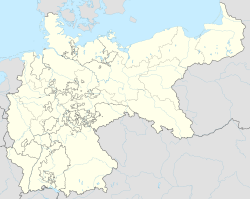Harburg-Wilhelmsburg
| Harburg-Wilhelmsburg (derelict) |
||
|---|---|---|
| Symbols | ||
|
||
| Basic data | ||
| Country | Prussia | |
| province | Hanover | |
| Administrative district | Luneburg | |
| Residents | 110,000 (1927) | |
| founding | July 1, 1927 | |
| Given up | April 1, 1938 | |
| politics | ||
| mayor | Ludwig Bartels (politician, 1884) | |
Coordinates: 53 ° 28 ' N , 9 ° 59' E
Harburg-Wilhelmsburg was a town in the Prussian province of Hanover , in the administrative district of Lüneburg . It was formed on July 1, 1927 through the unification of the Harburg district , with the incorporated communities Heimfeld and Wilstorf (since 1888), Lauenbruch (1906) and Eißendorf (1910) and the urban district (since 1925) Wilhelmsburg and also declared a municipal district.
By merging the cities of Harburg / Elbe and Wilhelmsburg, Prussia wanted to improve the economic situation compared to its strong neighbor Hamburg . Harburg-Wilhelmsburg had around 110,000 inhabitants at that time and was therefore a large city . Harburg remained the seat of the district administration for the district of Harburg (although the city district was not one of them). The former Lord Mayor of Harburg, Walter Dudek (SPD) , became the Lord Mayor of this newly formed city .
In 1928 it was possible to form a port community between the Port of Hamburg and the Prussian ports of Altona and Harburg. The construction of the fourth Harburg seaport basin at the former location of Lauenbruch also fell during this period .
After the National Socialists came to power in 1933, Mayor Dudek was forced out of office at gunpoint. Ludwig Bartels was appointed as his successor.
Within the framework of the Greater Hamburg Law , Harburg-Wilhelmsburg was incorporated into the State of Hamburg with effect from April 1, 1937, together with other municipalities and cities in Prussia . With effect from April 1, 1938, the city lost its independence and merged with the city of Hamburg and the other Hamburg areas in the new (unified) city of Hamburg . Today, Harburg, like the places in the former urban district, is a district. Together with these, it forms the core area of Hamburg's Harburg district . The Wilhelmsburg district was spun off from the Harburg district on March 1, 2008 and assigned to the Hamburg-Mitte district .
During the Second World War, the district administration for the Harburg district was also destroyed by bombing and relocated to Winsen (Luhe) in 1944 . The district of Harburg was not affected by the Großhamburg law and is now part of Lower Saxony.
Others
There was a Jewish community in Harburg. In 1862/63 she built a synagogue with about 100 seats on Eißendorfer Strasse . The community had around 300 members around 1900. The Harburg synagogue was completely looted and partially set on fire on the evening of November 10, 1938 (i.e. one day after the Reichspogromnacht ).
Individual evidence
- ↑ Harburg-Wilhelmsburg district (Hanover). In: territorial.de. Retrieved October 12, 2017 .
- ↑ Harburg-Wilhelmsburg district (Hamburg). In: territorial.de. Retrieved October 12, 2017 .
- ↑ Law on Greater Hamburg and other area adjustments of January 26, 1937, Art. 1 (RGBl. 1937 I p. 91)
- ^ The Hamburg Jews in the Nazi State 1933 to 1938/39 , Volume I, p. 408.
- ↑ ibid. P. 421

